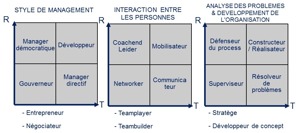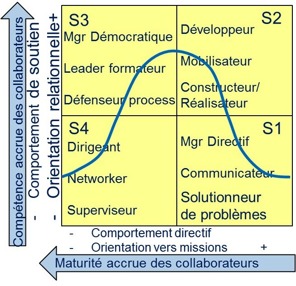LEADERSHIP STYLE CONCEPTS
When defining the different leadership styles that could appear in a leadership style portfolio, LDpe started off with making an inventory of styles we saw leaders use in different situations. A large number of possible styles were found. Having made this inventory, each of the styles was related to a number of the well defined competences of the LDT competence model.
To create an overlaying structure, the styles were ordered into three dimensions.
Management Style:
from the perspective of a leader’s role as manager
People Interaction:
from the perspective of the interaction with others
Organisational Development:
from the perspective of the organisation
Inspired by the work of Blake & Mouton, Reddin and Blanchard & Hersey, the styles were as well ordered in the managerial grid and the four dimensions of the situational leadership model.
In this way the situational leadership model has got 3 dimensions (see picture to the right) and the leader’s style can vary not solely in guiding his subordinates, but also in matters concerning his role (e.g. in taking decisions and take responsibility) or matters concerning the organisation.
Every leader has a unique combination of styles that allow him to successfully operate in different situations.
We call it his style portfolio.
The LDT measures the style portfolio and helps the leader to further develop it by simulating individual development scenarios for each leader.
This video from the Centre of Leadership explains the idea behind the Hersey & Blanchards concept of situational leadership
Management and Leadership Style Theories
The origin of theories on management come from the Scientific Management (Taylor) and the Administrative School (Fayol); up to then organisations were seen as bureaucratic systems and attention was only given to organisational processes.
·In the 1940’s and 1950’s the Human Resource movement (Lewin) developed. It more or less started with Western Electric’s Hawthorne experiments; this movement brought attention for the relation between leaders and their subordinates
The first typology on leadership styles was defined in the 1960’s (Likert, New patterns of management); three types of leadership styles dominated the dialogue: the democratic leader, the autocratic leader and the ‘laisser-faire’ leader; the thinking of ‘good’ and ‘bad’ in leadership still dominated the dialogue
A more systematic approach in management and leadership style theories was the development of the managerial grid (Fisher and Fleischman, Blake and Mouton)
In the early 1970’s Reddin developed the 3-D theory in which he introduced the concept of management effectiveness
Blanchard and Hersey build in the 1980’s further on Reddin’s theory and developed the Situational Leadership Model
In the 1990’s the more dynamic context of organisations led to a new theories, focusing on the difference between operational management and change management: e.g. Ralph Stacey on ordinary management and extra-ordinary management.
The LDT leadership style concepts as 3 dimensions in Hersey & Blanchards situational leadership model






